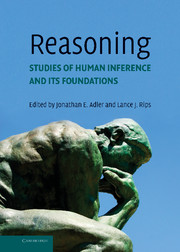25 - Belief Revision
Published online by Cambridge University Press: 05 June 2012
Summary
Introduction
The terms “belief revision” and “belief change” refer to the change of a system of beliefs or opinions in response to new information, in particular to information that is inconsistent with this system. In the 1960s and 1970s, works of Isaac Levi, William Harper, and Brian Ellis prepared the ground for systematic studies of belief change processes. In the 1980s, a seminal research paradigm of belief revision was established by Carlos Alchourrón, Peter Gärdenfors, and David Makinson (also known as “AGM”) who discovered a common structure in the logic of normative systems and of the logic of counterfactual conditionals – areas which turned out to be structurally related and were merged into the field of belief change (also known as “theory change”). The AGM paradigm is a classic by now that has in many ways been extended and revised. Still almost all new theories that are being proposed today define themselves in relation to the basic ideas of AGM.
Belief revision theories are different from descriptive psychological investigations or investigations of theory dynamics as conducted in the philosophy of science in that they provide abstract logical postulates for rational revision processes, as well as construction recipes for belief changes on the basis of certain revision-guiding structures. At present, research in belief revision is an interdisciplinary undertaking in logic, philosophy, computer science, and, to a lesser extent, in economics and cognitive science.
Information
- Type
- Chapter
- Information
- ReasoningStudies of Human Inference and its Foundations, pp. 514 - 534Publisher: Cambridge University PressPrint publication year: 2008
References
Accessibility standard: Unknown
Why this information is here
This section outlines the accessibility features of this content - including support for screen readers, full keyboard navigation and high-contrast display options. This may not be relevant for you.Accessibility Information
- 6
- Cited by
